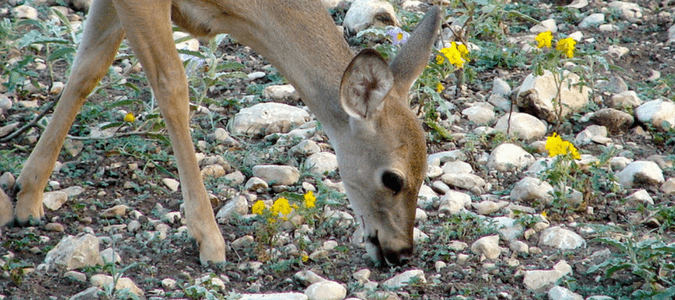
Is your yard a deer buffet? Do you plant a garden, only to wake up and discover your strawberries are trampled, your tomatoes have mysteriously vanished, and your greens are now sad little stubs? Thanks to deer, are your peach trees anything but peachy?
In many parts of San Antonio, deer face dwindling habitats and increased populations. In their search for their next meal, deer often find our yards a suitable substitute. As anyone with deer will tell you, they seem to eat almost everything.
Below we’ll look at ways you can make your yard and gardens less appetizing to deer and what deer proof plants you can add to your landscape.
Discourage Deer Visitors
When it comes to deer, you have a few lines of defense. You can make it difficult to get into your garden, you can try repelling the deer with chemical and physical tactics, and you can choose deer-resistant plants so they look elsewhere for their next meal.
Physical barriers
- Install fencing that is 8 feet tall to prevent deer from being able to jump inside.
- Use electric fencing that can be activated during peak periods in the spring and fall.
- Try privacy fencing or thick hedges of boxwood, short-needle spruce, or other dense shrubs. Deer tend to avoid jumping into spaces they can’t see.
Repellents
- Deer don’t like new or unfamiliar objects. Add moving, shiny, or noisy elements to your yard. Windchimes, pinwheels, flags, glass and mirrored ornaments, scarecrows, and statues can all discourage a hungry deer.
- Install bright lights. Deer usually are most active at dawn and dusk. A sudden bright light on a motion sensor will frighten them away.
- Plant prickly shrubs. Deer don’t like anything with thorns, prickles, or hairy textures.
- Try chemical repellents. When searching for a meal, deer use their sense of smell first and foremost. Throw them off with unappetizing odors. There’s Havahart’s Deer Away Big Game Repellent, a product that smells like rotten eggs. Or try Deer Off, which deters deer because of its hot pepper taste. Hang fabric softener sheets or bars of soap in stockings from trees or fence lines. Try socks with pet or human hair or blood meal.
- Put your dog to work. The smell of a dog, as well as their barking and running around, will discourage deer.
- Protect plants from deer. Cover plants with netting to make it difficult for deer to eat. Use various wraps to protect plant stems and young tree trunks.
Note that a single deterrent strategy may not be enough, especially if deer are exceptionally hungry. It’s also important to change things up from time to time, moving items, and using different deterrents, because deer will learn that some deterrents won’t actually harm them.
Deer-Resistant Plants
If you’ve done everything you can think of to discourage deer and they still pay your garden a daily visit, you can modify your landscaping to better coexist with the deer.
Deer prefer plants that are soft, sweet, full of moisture, and high in protein. They love beans and peas and will devour pretty much all fruit, vegetables, and berries. They also love azaleas, thornless roses, impatiens, and pansies.
Many native wildflowers, such as lantana, yarrow, Mexican hat, and salvias are deer-resistant. Due to their strong aromas, many culinary herbs are likewise deer-resistant. If you have a vegetable or fruit garden, planting highly aromatic herbs around your tomatoes or strawberries may help to discourage the deer.
Below are some of the plants deer generally avoid, as recommended by the Texas Department of Agriculture’s Go Texas program and by Texas A&M’s AgriLife Extension Service. Many of them have textures, aromas or taste that are unappealing to deer.
Deer-Resistant Shrubs
- Agarita
- Firebush
- Gray Cotoneaster
- American Beautyberry
- Boxleaf Euonymus
- Elaeagnus or Silverberry
- Japanese Boxwood
- Japanese Yew
- Nandina
- Oleander
- Pomegranate
- Primrose Jasmine
- Texas Mountain Laurel
- Yaupon Holly
- Flameleaf Sumac
- Chaste trees
Deer-Resistant Herbs
- Rosemary
- Germander
- Thyme
- Sage
- Basil
- Lemon Balm
- Lemon Grass
- Lemon Verbena
- Chives and Garlic Chives
- Mexican Oregano
- Catnip and Catmint
- Wormwood
- Yarrow
- Oregano
Deer-Resistant Flowers & Bedding Plants
- Ageratum
- Amaryllis
- Bluebonnet
- Butterfly Weed (Asclepias)
- Crossvine
- Datura (also known as Angel’s Trumpet)
- Most species of Artemisia
- Most species of Salvia
- Bearded Iris
- Flame acanthus
- Plumbago
- Globe amaranth
- Copper Canyon Daisy
- Dusty Miller
- Sedum
- Hummingbird Bush
- Lantana
- Lamb’s Ear
- Snapdragons
- Pigeonberry
- Rock Rose
- Marigold
- Mexican Honeysuckle
- Zinnia
- Skullcap
Other Large Ornamental Plants Deer Detest
- Prickly Pear Cactus
- Yucca and Sotol
- Agave
- Maiden Grass
- Pampas Grass
- Purple Fountain Grass
Deer Proofing Your Trees
According to the Texas Department of Agriculture, no trees can be considered deer-resistant enough to leave unprotected. If you want to plant new trees, be sure to circle them with fencing or other protection until they are tall enough to avoid being munched by a deer.
Have Deer Gotten the Best of You?
If the neighborhood deer make it difficult to keep your yard healthy and attractive, contact us at ABC Home & Commercial Services. We can send out our landscape experts to review your current garden and landscape and offer recommendations for changes you can make to “deer-proof” your yard.